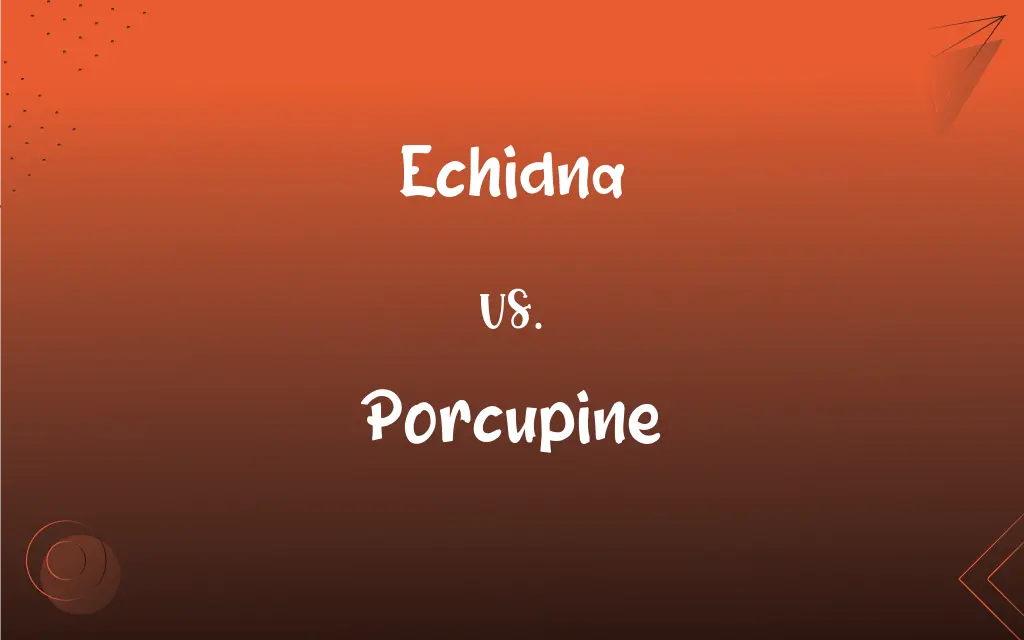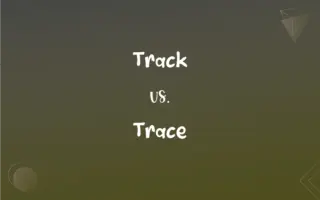Echidna vs. Porcupine: What's the Difference?
Edited by Aimie Carlson || By Janet White || Updated on November 12, 2023
Echidna is a small, egg-laying mammal native to Australia and New Guinea, known for its spines and snout. Porcupine is a rodent known for its coat of sharp spines or quills, found in the Americas, Europe, and Asia.

Key Differences
Echidnas are monotremes, a rare type of mammal that lay eggs, found primarily in Australia and New Guinea. They have a distinctive appearance with a snout and spines. Porcupines, conversely, are rodents and give birth to live young. They are larger than echidnas and are known for their sharp quills, which are used as a defense mechanism against predators.
The diet of an echidna consists mainly of ants and termites. They use their long, sticky tongues to capture prey. Their limbs are adapted for digging. Porcupines have a more varied diet, including plants, tree bark, and small insects. They are less adapted for digging but are good climbers and can be found in trees.
In terms of habitat, echidnas are adapted to a variety of environments, including forests, deserts, and snowy mountains. They are solitary creatures and have a low body temperature compared to other mammals. Porcupines are also adaptable but are more commonly found in wooded areas. They are also primarily solitary but have higher body temperatures than echidnas.
The reproductive process of echidnas is unique, with females laying a single leathery egg that is incubated in a pouch. The young, known as puggles, are born undeveloped and continue to grow in the mother's pouch. Porcupines, in contrast, have a more typical mammalian reproductive process with a gestation period followed by the birth of one or two well-developed young.
The defensive mechanisms of echidnas include curling into a ball with spines outward, a common trait among animals with spines. Their spines are shorter and more numerous. Porcupines have longer, sharper quills that can detach and embed in predators, providing a more active defense mechanism. Their quills are fewer in number but more effective at deterring larger predators.
ADVERTISEMENT
Comparison Chart
Classification
Monotreme (egg-laying mammal)
Rodent (gives birth to live young)
Diet
Ants, termites
Plants, bark, insects
Habitat
Forests, deserts, mountains
Primarily wooded areas
Reproduction
Lays eggs, pouch incubation
Live birth, typical mammalian process
Defense Mechanism
Curl into a ball, shorter spines
Detachable sharp quills
ADVERTISEMENT
Echidna and Porcupine Definitions
Echidna
An egg-laying mammal with a distinctive snout and spiny coat.
We saw an echidna curled up in a ball when we approached.
Porcupine
A rodent that feeds on plants and can climb trees.
The porcupine was skillfully climbing the tree to reach the leaves.
Echidna
A small, spiny monotreme native to Australia and New Guinea.
The echidna used its snout to search for ants in the soil.
Porcupine
A mammal known for its sharp, detachable quills.
We found porcupine quills stuck in the bark of the tree.
Echidna
A mammal known for its burrowing and ant-eating habits.
The echidna burrowed into the ground to escape the heat.
Porcupine
A forest-dwelling rodent with a distinctive spiny appearance.
The porcupine’s spiny coat helps protect it from predators.
Echidna
A unique mammal characterized by its egg-laying reproduction.
The echidna is one of the few mammals that lay eggs.
Porcupine
An animal with a defensive mechanism of releasing sharp spines.
The dog learned to avoid the porcupine after a painful encounter.
Echidna
An Australian mammal with a body covered in spines for defense.
The echidna's spines are an effective deterrent against predators.
Porcupine
A large rodent with a coat of sharp quills for protection.
The porcupine raised its quills as a warning to the approaching fox.
Echidna
Any of several nocturnal burrowing egg-laying mammals of the genera Tachyglossus and Zaglossus of Australia, Tasmania, and New Guinea, having a spiny coat, a slender snout, and an extensible sticky tongue used for catching insects.Also called spiny anteater.
Porcupine
Any of various rodents of the family Hystricidae, of Eurasia and Africa, or the family Erethizontidae, of the Americas, having long, sharp, erectile quills.
Echidna
Any of the species of small spined monotremes in family Tachyglossidae, the four extant species of which are found in Australia and southern New Guinea.
Porcupine
Any of several rodents of either of the taxonomic families Hystricidae (Old World porcupines) or Erethizontidae (New World porcupines), both from the infraorder Hystricognathi, noted for their sharp spines or quills, which are raised when the animal is attacked or surprised.
Echidna
A monster, half maid and half serpent.
Porcupine
Any Old Word rodent of the genus Hystrix, having the back covered with long, sharp, erectile spines or quills, sometimes a foot long. The common species of Europe and Asia (Hystrix cristata) is the best known.
Echidna
A genus of Monotremata found in Australia, Tasmania, and New Guinea. They are toothless and covered with spines; - called also porcupine ant-eater, and Australian ant-eater.
Porcupine
Any species of Erethizon and related genera, native of America. They are related to the true porcupines, but have shorter spines, and are arboreal in their habits. The Canada porcupine (Erethizon dorsatus) is a well known species.
Echidna
New Guinea echidnas
Porcupine
Relatively large rodents with sharp erectile bristles mingled with the fur
Echidna
Burrowing spine-covered monotreme of Australia having a long snout and claws for hunting ants and termites
FAQs
Do echidnas have teeth?
No, echidnas do not have teeth; they use their long tongues to eat.
Can porcupine quills grow back after they are lost?
Yes, porcupines can regrow lost quills.
How long do echidnas live?
Echidnas can live for up to 50 years in the wild.
Are porcupines aggressive animals?
Porcupines are generally not aggressive but will defend themselves if threatened.
Are echidnas found outside of Australia and New Guinea?
No, echidnas are native only to Australia and New Guinea.
Are porcupines solitary animals?
Yes, porcupines are primarily solitary except during mating season.
Can echidnas swim?
Yes, echidnas are capable swimmers.
Do echidnas hibernate?
Echidnas do not hibernate, but they can enter a state of torpor in cold weather.
Are echidnas fast movers?
No, echidnas are slow-moving animals.
How do porcupines protect their young?
Porcupine young are born with soft quills that harden after a few days for protection.
Are all porcupine species nocturnal?
Many porcupine species are nocturnal, but not all.
Can porcupines shoot their quills?
No, porcupines cannot shoot their quills, but they can detach easily and embed in predators.
Do echidnas have good eyesight?
Echidnas have poor eyesight but a good sense of smell.
Can porcupine quills cause infections?
Yes, if not removed properly, porcupine quills can cause infections.
What is the gestation period for a porcupine?
The gestation period for porcupines varies by species but is generally around 7 months.
Do porcupines climb trees for food or safety?
Porcupines climb trees both for food, like leaves and bark, and for safety.
How big can porcupines get?
Porcupines can grow quite large, with some species reaching over 30 pounds.
What is the main predator of echidnas?
The main predators of echidnas are larger mammals and birds of prey.
Is it true that echidnas have a low body temperature?
Yes, echidnas have a relatively low body temperature compared to other mammals.
Can echidnas be kept as pets?
Echidnas are wild animals and are not suitable as pets.
About Author
Written by
Janet WhiteJanet White has been an esteemed writer and blogger for Difference Wiki. Holding a Master's degree in Science and Medical Journalism from the prestigious Boston University, she has consistently demonstrated her expertise and passion for her field. When she's not immersed in her work, Janet relishes her time exercising, delving into a good book, and cherishing moments with friends and family.
Edited by
Aimie CarlsonAimie Carlson, holding a master's degree in English literature, is a fervent English language enthusiast. She lends her writing talents to Difference Wiki, a prominent website that specializes in comparisons, offering readers insightful analyses that both captivate and inform.































































